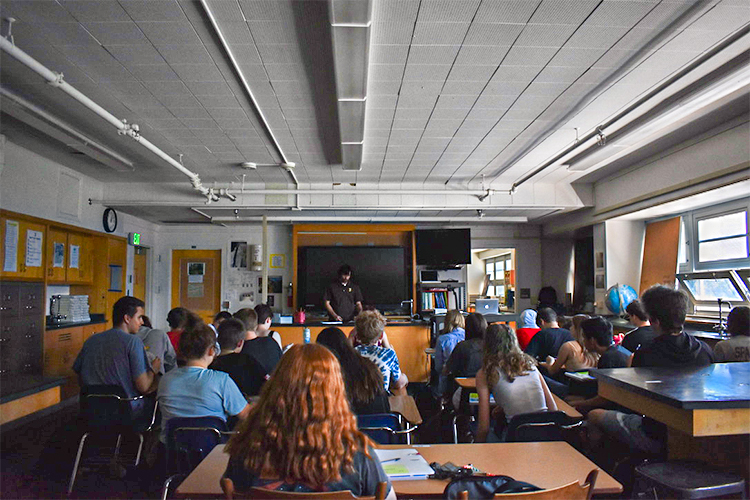
Mr. Butera teaches a crowded class of 33 students. photo by Ava Ward
Denver Public Schools’ student-to-teacher ratios are rising, taking stress levels with them.
The operation of a classroom requires meticulous attention to detail. The latest educational gadgets must be prepped and charged to avoid a mid-class tech crisis; seating charts must be plotted to cater to every student’s poor vision or attention-deficits; assignments must be distributed and collected with exceedingly efficient accuracy as to avoid half an hour of weaving through desks. Under the right circumstances, classrooms can function as fluidly as a well-oiled machine. Unfortunately, under the tidal wave of students who have crashed through Thomas Jefferson High School as of late, student-to-teacher ratios are rising, burying TJ’s well-oiled machines under a torrent of teenagers.
“There is a nice happy medium. I want to have enough students so that we can have groups and teamwork in class, but if there are too many students and too many groups, it feels like I’m just putting out fires all over the class and I can’t help everybody that I need to,” reasoned Katie Fitzgerald, a math teacher at TJ. “It raises my stress levels for sure.” Fitzgerald’s observations align with international research on the upshots of lower student-to-teacher ratios. The Student-Teacher Achievement Ratio (STAR) Program, one of the first large-scale experiments on class size, revealed that students in smaller classes showed more positive behavior towards engagement and learning than students in larger classes. Despite these findings, class sizes in DPS have surpassed 30 students as of this year, according to Westword. It is in these overcrowded classrooms that Fitzgerald’s fears come to fruition. With every additional pupil, teachers are forced to act less like instructors and more like babysitters.
Speaking from his experience with large class sizes, biology teacher Scott Thomas explained, “Students don’t get the individual attention they need because it’s too hard for the teacher to deal with so many demands.” It is difficult for students to feel confident in the curriculum when their instructor is constantly being sidetracked by outbursts and distractions. Moreover, a preoccupied teacher pushes teenagers’ self-control to the limit. “One of the issues that comes with a high student-to-teacher ratio is more behavior mishaps,” commented Skylar Viener, a junior. “There are more students who are unwilling to pay attention because they know they can get away with it.” Viener’s conjectures are not baseless. The STAR Program’s research indicates that crowded classes had more behavior referrals and poorer student conduct than their smaller sized counterparts. When a teacher has the capacity to devote their energy to the subject at hand, their enthusiasm becomes infectious. Pupils can enjoy an environment where they learn to appreciate academics.
Rising student-to-teacher ratios are particularly problematic for TJ when one considers its diverse profile. The STAR study found that while all students improved from smaller class sizes, the results for black students were much more dramatic. Black students in the smaller classes outperformed black students in larger classes at a rate two to three times higher than the white students did over their white counterparts. In addition, the high school transcripts of former STAR students showed that those who had been in smaller classes for at least three years—particularly students from low-income backgrounds—were significantly more likely to graduate from high school. In a country where minority groups are frequently debilitated by society, it is crucial that education, the great equalizer, is structured to serve those of all backgrounds. TJ boasts a wide variety of ethnicities and socioeconomic status; if action is not taken to reduce class sizes, minorities will be shunted to the back, forced to continue the cycles of poverty and incarceration.
Circumventing large class sizes is no easy task. “It’s a difficult problem because the only real way to reduce that ratio is to have fewer students or more teachers,” explained Thomas. “Obviously we want to bring as many students as we can into the district, so we need more teachers, which means we need more money.” Fitzgerald, Thomas, and Viener all agree that schools do not receive sufficient funding on a state and federal level. Unfortunately, between the U.S. Secretary of Education’s frequent endorsement of private schools and the Federal Reserve’s ominous warnings of a declining economy, extra cash does not seem likely to flow Denver Public Schools’ way. Still, there are opportunities for progress to be made. “I think DPS is working on it,” acknowledged Thomas. Some, like Viener, postulate that teacher assistants may be the most cost-effective way to bring down the student-teacher ratio. Others predict that curricula will have to be revamped to better suit large class sizes. Public outcry, financial surveillance, and creativity will be the key factors in pulling down the student-to-teacher ratios.
In overcrowded classrooms, one of the most invaluable benefits of public education is lost: student-teacher relationships. “I can get to know 20 students a lot easier than I can get to know 35,” contended Fitzgerald. For teachers, healthy relationships with their class can preempt burnout. For students, it is often a connection with a teacher that gets them out the door in the morning. “I really value that connection,” Viener confessed. If we do not give schools the resources they need, we risk producing a generation bereft of the thirst for learning. High schoolers will graduate knowing nothing more than how to count down the minutes until the bell rings. When the world realizes that education is our most powerful weapon for change, students will finally be given the resources to build an extraordinary future.